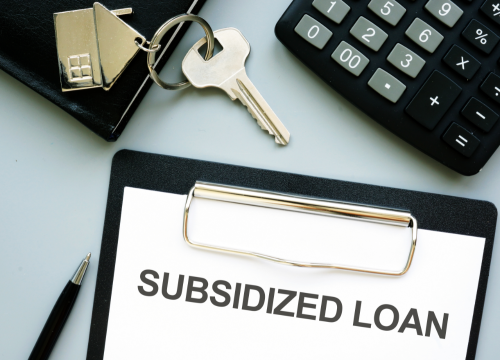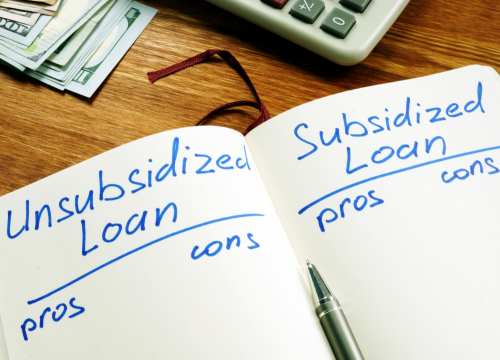Difference Between Subsidized And Unsubsidized Loans
Navigating college expenses can be a real challenge, especially with the ever-rising tuition fees. Many individuals opt for loans to ease their financial burden, but it’s important to recognize the different types available. That being said, the U.S. Department of Education (ED) offers two types of federal direct loans: subsidized and unsubsidized. Both offer numerous benefits, but which one’s right for you?
In this article, we break down the fundamental differences between subsidized and unsubsidized loans to help you choose the right one.

What is a subsidized loan?
A subsidized loan is a type of Federal student loan offered by the U.S. Department of Education. It is given to undergraduate students seeking financial assistance. The government covers the interest while the borrower is in school at least half-time, during the grace period after leaving school, and during periods of deferment (when payments are temporarily postponed).
Eligibility for subsidized loans is determined based on financial need. The Free Application for Federal Student Aid (FAFSA) is used to assess this need, considering factors such as family income and the cost of attending school. The interest rates are set by the government and may vary each academic year.

What is an unsubsidized loan?
Unsubsidized loans are offered to both undergraduate and graduate students, but they do not need to demonstrate financial need to avail this loan. The amount you can borrow is determined by your education level and dependency status. Unlike subsidized loans, unsubsidized loans accrue interest from the time they are disbursed to the borrower.
Interest begins as soon as the loan is disbursed. This means that even while the borrower is in school, during the grace period, and in deferment or forbearance, the interest continues to accumulate. Unsubsidized loans have fixed interest rates set by the government. The rates may vary each academic year but are generally higher than the rates for subsidized loans.
Difference between Subsidized and Unsubsidized Loans
Interest Subsidy
The government covers the interest on subsidized loans while the borrower is in school at least half-time, during the grace period after leaving school, and in periods of deferment. The borrower is not responsible for the interest during these periods.
Interest on unsubsidized loans begins accruing from the time the loan is disbursed. The borrower is responsible for the interest during all periods, including while in school, during the grace period, and in deferment or forbearance.
Financial Need
Eligibility for subsidized loans is determined based on financial need through the Free Application for Federal Student Aid (FAFSA). Only undergraduate students with demonstrated financial need qualify for subsidized loans.
Eligibility for unsubsidized loans is not based on financial need. Both undergraduate and graduate students can qualify for unsubsidized loans, making them available to a broader range of students.
Interest Rates
Subsidized loans typically have lower fixed interest rates compared to unsubsidized loans. The interest rates are set by the government and may vary each academic year.
Unsubsidized loans also have fixed interest rates set by the government, but these rates are generally higher than those for subsidized loans.
Availability for Graduate Students
Generally, subsidized loans are only available to undergraduate students with demonstrated financial need. However, both undergraduate and graduate students are eligible for unsubsidized loans. Graduate students often rely on unsubsidized loans as a primary source of federal student aid since subsidized loans are not available to them.
Loan Limits
The annual and aggregate loan limits for subsidized loans are generally lower than those for unsubsidized loans. The total amount a student can borrow is limited. Unsubsidized loans have higher annual and aggregate loan limits compared to subsidized loans. The total amount a student can borrow from both subsidized and unsubsidized loans combined is subject to limits.
Subsidized vs. Unsubsidized Loans: Comparison Chart

Summary
In a nutshell, both are federal direct loans offered by the U.S. Department of Education and must be paid back with interest. However, eligibility for subsidized loans is determined based on financial need, while eligibility for unsubsidized loans is not based on financial need. Both undergraduate and graduate students can qualify for unsubsidized loans. It’s essential for students considering federal student loans to carefully review the terms and conditions of both subsidized and unsubsidized loans.
FAQs
What’s better, subsidized or unsubsidized?
Subsidized loans are generally better because the government pays the interest while you’re in school or during certain deferment periods. However, unlike subsidized loans, both undergraduate and graduate students can qualify for unsubsidized loans.
What is a direct unsubsidized loan?
Direct unsubsidized loans are federal student loans where the borrower is responsible for all interest that accrues, even during school or deferment periods.
What is a parent PLUS loan?
A Parent PLUS loan is a federal loan that parents of dependent undergraduate students can use to help pay for college.
How can you reduce your total loan cost?
You can reduce your total loan cost by making extra payments, refinancing at a lower interest rate, or exploring loan forgiveness programs.
What are the disadvantages of an unsubsidized loan?
The main disadvantage is that you’re responsible for all accrued interest, which can increase the total amount you repay.
How many days after missing a student loan payment do your loans go into default?
It’s typically after about 270 days of non-payment that federal student loans go into default.
Which student loans to pay off first?
It’s often recommended to prioritize higher-interest loans first to minimize overall interest payments.
Can I pay off my student loans all at once?
Yes, you can pay off your student loans in a lump sum if you have the means to do so. You can check with your loan servicer for any specific procedures.
Should I pay off my student loans as fast as possible?
It depends on your financial situation. If you can afford to pay them off quickly without sacrificing other financial goals, it may be beneficial to do so. Consider factors like interest rates and other financial priorities.
- Difference Between Caucus and Primary - June 18, 2024
- Difference Between PPO and POS - May 30, 2024
- Difference Between RFID and NFC - May 28, 2024
Search DifferenceBetween.net :
Leave a Response
References :
[0]Helhoski, Anna. “Which to Borrow: Subsidized vs. Unsubsidized Student Loans.” NerdWallet, 2 June 2023, www.nerdwallet.com/article/loans/student-loans/unsubsidized-student-loans.
[1]Lake, Rebecca. “Subsidized vs. Unsubsidized Student Loans: Which Is Best?” Investopedia, 2 Sept. 2023, www.investopedia.com/personal-finance/federal-direct-loans-subsidized-vs-unsubsidized/.
[2]The U.S. Department of Education offers low-interest loans to eligible students to help cover the cost of college or career school. U.S. Department of Education, Federal Student Aid. studentaid.gov/understand-aid/types/loans/subsidized-unsubsidized. Accessed 10 Jan. 2024.
[3]Lee, Medora and Kathleen Wong. “What's the difference between subsidized and unsubsidized federal student loans?” USA Today, 3 July 2023, www.usatoday.com/story/money/2023/06/12/federal-student-loans-subsidized-unsubsidized/70278975007/.
[4]Image credit: https://www.canva.com/photos/MADm6I11ua8-unsubsidized-vs-subsidized-loans-pros-and-cons-in-the-note-pad-/
[5]Image credit: https://www.canva.com/photos/MADpncapFjg-conceptual-photo-showing-printed-text-subsidized-loan/
